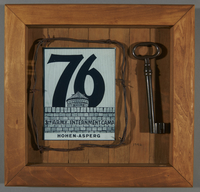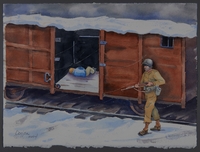Overview
- Description
- Collection consists of a photograph of German-American and Japanese-American internees at Ellis Island in 1943 and an aerial photograph of the Crystal City Internment Camp in Crystal City, Texas in 1944-45,
- Date
-
inclusive:
1943-circa 1945
- Credit Line
- United States Holocaust Memorial Museum Collection, Gift of Arthur Jacobs.
- Collection Creator
- Arthur D. Jacobs
- Biography
-
Arthur D. Jacobs (b. 1933) was born to Lambert Dietrich (1908-1983) and Paula (nee Knissel, 1906-1976) Jacobs in Brooklyn, New York. Lambert immigrated to the United States from Germany in 1928, and Paula immigrated in 1929. Two years later, the couple married, and Paula gave birth to Arthur’s brother, Lambert Walter (nicknamed Sonney, b. 1931). Lambert worked as a maintenance mechanic for a factory power plant and Paula worked for a time in a small knitting workshop. The family only spoke English at home, and the boys grew up with no interest in Germany or German culture.
In 1938, Lambert submitted his declaration for naturalization, but he never had the opportunity to complete the process. On September 1, 1939, Germany invaded western Poland, leading Britain and France to declare war two days later. The United States stayed out of the conflict, but Lambert saw an ad in the newspaper directing male German citizens to register at the German Consulate; he felt compelled to comply. The influx of refugees from Europe into the United States led to an immigration crisis, and many American citizens grew suspicious that there were German spies among these immigrants. In June 1941, the State Department began denying entry visas to anyone with family still in Axis-occupied territory.
In 1941, four days after the December 7 Japanese attack on the US Navy at Pearl Harbor, Germany declared war on the United States. An executive order in February 1942 allowed government agencies to rationalize the detainment of American citizens and noncitizens living in the United States. In four separate cases, the US Supreme Court determined that war powers of the government legally allowed American citizens to be detained in camps. Over 110,000 Japanese Americans and 14,000 people born in Axis countries—who had not yet become American citizens—were forced into internment camps around the country. On the East Coast, the United States Department of Justice investigated and interned selected German nationals they thought might be dangerous.
In June 1943, an FBI agent and an NYPD detective searched and ransacked the Jacobs family home in Brooklyn, based on an anonymous source accusing Lambert of participation in a conspiracy. Although they failed to find anything of concern, the home was searched on two more occasions. Lambert was interrogated at length multiple times after his name was allegedly found on an applicant list for Nazi party membership. Although Lambert denied these charges and the Alien Enemy Hearing Board recommended his release, the Attorney General ordered his internment. On November 3, 1944, Lambert was arrested at his workplace and interned at the Ellis Island Immigration Station, in a camp run by Immigration and Naturalization Services.
By the end of February 1945, Paula had fallen ill and living without an income, she decided to give up their home. Paula and her sons became voluntary internees at Ellis Island. Lambert requested to be transferred to the Crystal City Texas Family Internment Camp so that his whole family could live together. On April 26, the family boarded a train for Texas, arriving three days later.
In the Crystal City camp, the family was assigned to a two-room, unfinished house. They were able to finish and paint the inside, acquired furniture, and planted morning glories and castor bean trees outside. The quarters did not contain a bathroom or kitchen, so Arthur and his family used public toilet and shower facilities and ate in a communal dining hall, where Lambert got work as a cook and baker. Arthur regularly swam in the camp pool, attended movie screenings, and took jujitsu classes. He and his brother were enrolled in the camp’s German school, and he befriended both German and Japanese children interned at the camp. However, as people entered and left the camp, Arthur found it difficult to maintain friendships and he began keeping his distance.
On May 7, Germany surrendered to the Allies, but the United States government continued to deport people classified as “enemy aliens.” In early August, Lambert received his deportation notification. In October, not wanting the stigma of being a deportee, he and Paula volunteered to be repatriated, requesting that their sons join them. On December 1, the family was among 101 internees transported to Ellis Island, where they waited for their ship to depart the following month. Although Arthur and his brother were born in the US, they were not given American passports prior to their departure.
On January 27, 1946, the repatriates arrived in Bremerhaven, Germany, where they were met by a host of armed US soldiers. They received harsh treatment from the occupying forces, and without proof of their citizenship, Arthur and his brother were treated as German nationals. They were transported to Bremen under armed guard, and forced onto a train of boxcars. After almost four days with little nourishment, the train arrived in Ludwigsburg. The men were taken to Camp 76, a US Army internment camp at a former fortress and prison named Hohenasperg, while the women were taken to nearby Camp 77. After a week, Arthur and his brother were transferred to another camp in nearby Ludwigsburg. After their parents release in March, the family traveled to the British occupation zone to live with Arthur’s grandparents, just outside the American enclave of Bremen.
Without proof of American citizenship, Arthur and his brother continued to be treated as German nationals, and could not legally cross the border to enter Bremen or access any of the American institutions in the city. In March 1947, Arthur snuck into a US Army building, where he was questioned by the Provost Marshal. A few months later, he was offered a job working in the motor pool for the US Counter Intelligence Corps. While there, he met the wife of an American agent, who arranged for Arthur and his brother to live on a friend’s ranch in Kansas. The boys arrived back in the United States on November 10, 1947. In 1952, Arthur enlisted in the U.S. Air Force and reunited with his parents in Germany while he was stationed overseas.
Physical Details
- Language
- English
- Genre/Form
- Photographs.
- Extent
-
2 oversize folders
- System of Arrangement
- The collection is arranged as a single series.
Rights & Restrictions
- Conditions on Access
- There are no known restrictions on access to this material.
- Conditions on Use
- The donor, source institution, or a third party has asserted copyright over some or all of these material(s). The Museum does not own the copyright for the material and does not have authority to authorize use. For permission, please contact the rights holder(s).
- Copyright Holder
- Arthur D. Jacobs
Keywords & Subjects
Administrative Notes
- Holder of Originals
-
United States Holocaust Memorial Museum
- Legal Status
- Permanent Collection
- Provenance
- Donated to the United States Holocaust Memorial Museum by Arthur Jacobs in 2017.
- Record last modified:
- 2023-02-24 14:31:24
- This page:
- https://collections.ushmm.org/search/catalog/irn562944
Download & Licensing
- In Copyright
- Terms of Use
- This record is digitized but cannot be downloaded online.
In-Person Research
- Available for Research
- Plan a Research Visit
-
Request in Shapell Center Reading Room
Bowie, MD
Contact Us
Also in Arthur Jacobs collection
The collection consists of photographs, a watercolor painting, and a shadowbox display relating to the experiences of Arthur Jacobs in the United States and Germany during and after World
Date: 1943-2014

Barbed wire and a key in a shadow box display belonging to a German-American internee
Object
A collection of objects commemorating the February 1946 stay of Arthur Jacobs at Camp 76, a detention center for German repatriates used by the United States Army at Hohenasperg in Asperg, Germany. Arthur was born in New York to German parents. In November 1944, his father, Lambert Dietrich, was arrested on unsubstantiated information and interned at the Ellis Island Immigration Station as an enemy alien. In February 1945, Arthur, his brother, and his mother voluntarily joined Lambert at Ellis Island. At the end of April, the family was transferred to the Crystal City Texas Family Internment Camp. Facing deportation following the end of the war, Arthur’s parents volunteered to be repatriated to Germany, and took their children with them. They arrived in Germany in January 1946, met by a host of armed US soldiers. After almost four days traveling by boxcar with little nourishment, Arthur, his brother, and his father were taken to Camp 76, situated at a former fortress and prison named Hohenasperg. During the war, Hohenasperg was used for medical experimentation and as a collection center for Sinti and Roma families, but from 1945 to 1947, the US Army used it as a detention center for denazification and re-education. Without a passport to prove his American citizenship, Arthur was treated as a German national. Arthur and his brother were released after a week, as were their parents the following month. Arthur and his brother returned to the United States on November 10, 1947. Their parents remained in Germany, where Arthur traveled to reunite with them in June 1958.

Modern watercolor painting of a German-American internee as a child
Object
A watercolor artistic interpretation of the experience of Arthur Jacobs as he was transported by the United States Army from Bremen to Ludwigsburg, Germany in January 1946. Arthur was born in New York to German parents. In November 1944, his father, Lambert Dietrich, was arrested on unsubstantiated information and interned at the Ellis Island Immigration Station as an enemy alien. In February 1945, Arthur, his brother, and his mother voluntarily joined Lambert at Ellis Island. At the end of April, the family was transferred to the Crystal City Texas Family Internment Camp. Facing deportation following the end of the war, Arthur’s parents volunteered to be repatriated to Germany, and took their children with them. They arrived in Germany in January 1946, met by a host of armed US soldiers. After almost four days traveling by boxcar with little nourishment, Arthur, his brother, and his father were taken to Camp 76, situated at a former fortress and prison named Hohenasperg. During the war, Hohenasperg was used for medical experimentation and as a collection center for Sinti and Roma families, but from 1945 to 1947, the US Army used it as a detention center for denazification and re-education. Without a passport to prove his American citizenship, Arthur was treated as a German national. Arthur and his brother were released after a week, as were their parents the following month. Arthur and his brother returned to the United States on November 10, 1947. Their parents remained in Germany, where Arthur traveled to reunite with them in June 1958.



